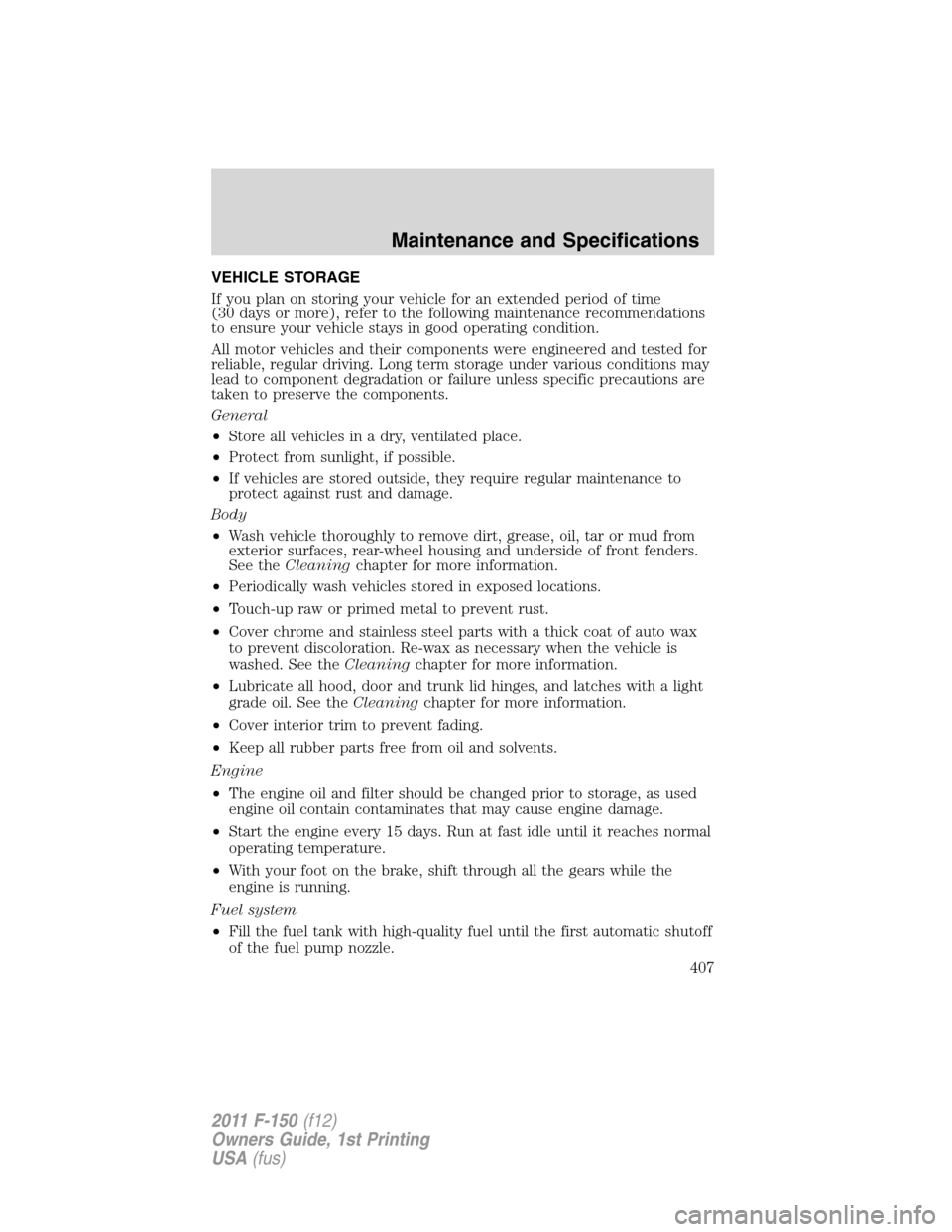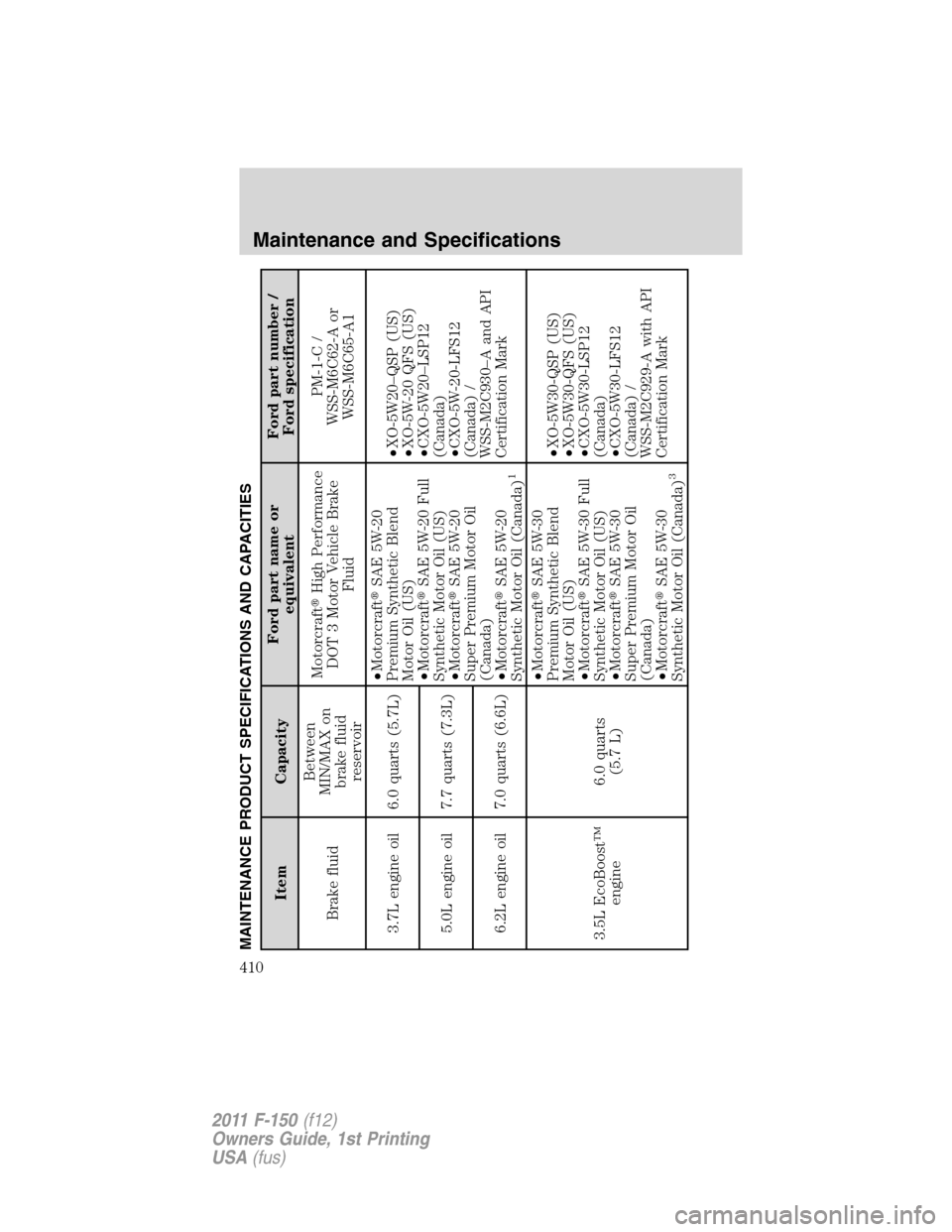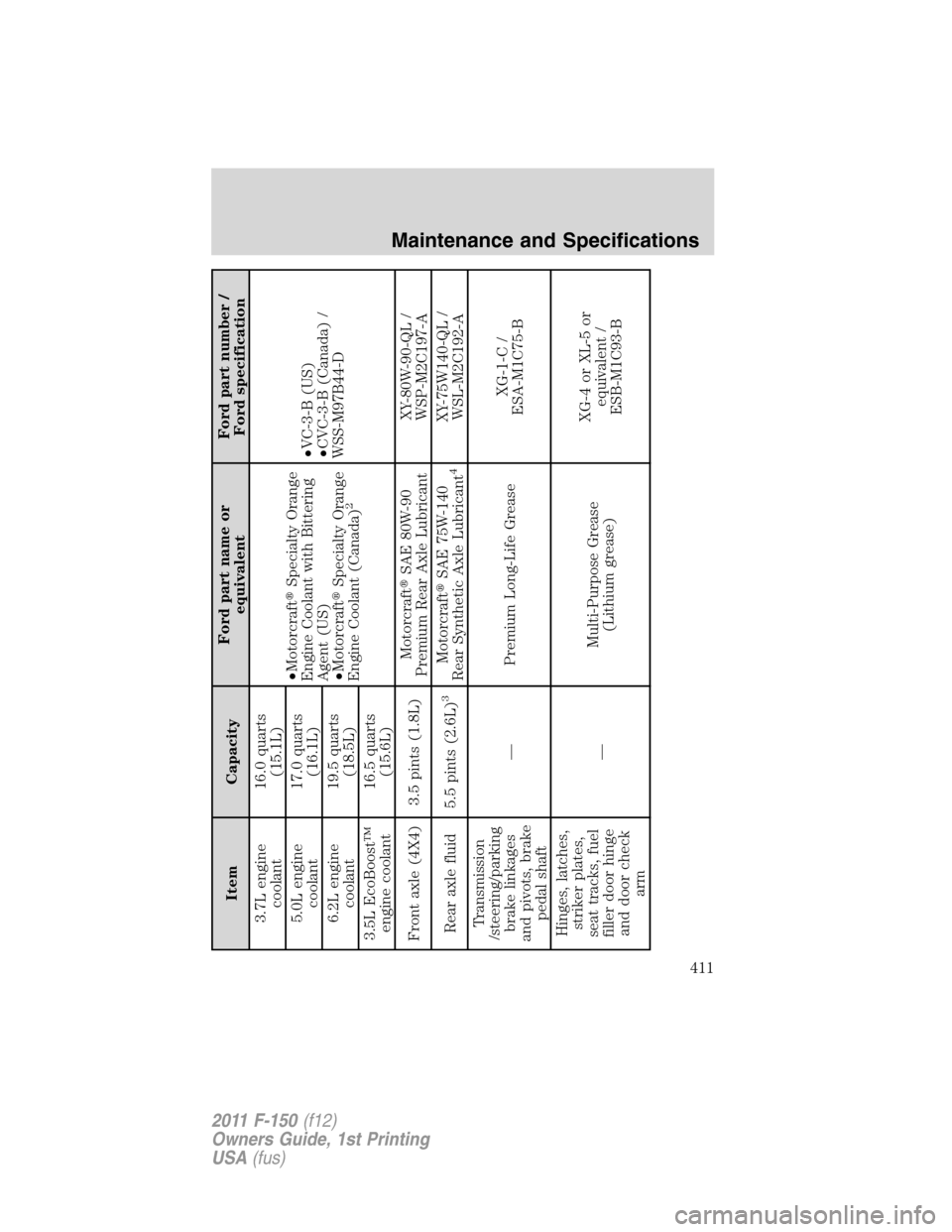Page 398 of 461

•You may want to turn off the speed control in hilly terrain if
unnecessary shifting between the top gears occurs. Unnecessary
shifting of this type could result in reduced fuel economy.
•Warming up a vehicle on cold mornings is not required and may
reduce fuel economy.
•Resting your foot on the brake pedal while driving may reduce fuel
economy.
•Combine errands and minimize stop-and-go driving.
Maintenance
•Keep tires properly inflated and use only recommended size.
•Operating a vehicle with the wheels out of alignment will reduce fuel
economy.
•Use recommended engine oil. Refer toMaintenance product
specifications and capacitiesin this chapter.
•Perform all regularly scheduled maintenance items. Follow the
recommended maintenance schedule and owner maintenance checks
found inscheduled maintenance information.
Conditions
•Heavily loading a vehicle or towing a trailer may reduce fuel economy
at any speed.
•Carrying unnecessary weight may reduce fuel economy (approximately
1 mpg [0.4 km/L] is lost for every 400 lb [180 kg] of weight carried).
•Adding certain accessories to your vehicle (for example bug
deflectors, rollbars/light bars, running boards, ski/luggage racks) may
reduce fuel economy.
•To maximize the fuel economy, drive with the tonneau cover installed
(if equipped).
•Using fuel blended with alcohol may lower fuel economy.
•Fuel economy may decrease with lower temperatures during the first
8–10 miles (12–16 km) of driving.
•Driving on flat terrain offers improved fuel economy as compared to
driving on hilly terrain.
•Transmissions give their best fuel economy when operated in the top
cruise gear and with steady pressure on the gas pedal.
•Four-wheel-drive operation (if equipped) is less fuel efficient than
two-wheel-drive operation.
Maintenance and Specifications
398
2011 F-150(f12)
Owners Guide, 1st Printing
USA(fus)
Page 402 of 461

POWER STEERING FLUID (6.2L V8 ENGINE ONLY)
Check the power steering fluid. Refer toscheduled maintenance
information.
1. Start the engine and let it run
until it reaches normal operating
temperature (the engine coolant
temperature gauge indicator will be
near the center of the normal area
between H and C).
2. While the engine idles, turn the
steering wheel left and right several
times.
3. Turn the engine off.
4. Check the fluid level in the reservoir. It should be between the MIN
and MAX lines. Do not add fluid if the level is in this range.
5. If the fluid is low, add fluid in small amounts, continuously checking
the level until it reaches the range between the MIN and MAX lines. Be
sure to put the cap back on the reservoir. Refer toMaintenance
product specifications and capacitiesin this chapter for the proper
fluid type.
BRAKE FLUID
The fluid level will drop slowly as
the brakes wear, and will rise when
the brake components are replaced.
Fluid levels between the MIN and
MAX lines are within the normal
operating range; there is no need to
add fluid. If the fluid levels are
outside of the normal operating
range, the performance of the
system could be compromised; seek
service from your authorized dealer
immediately.
Maintenance and Specifications
402
2011 F-150(f12)
Owners Guide, 1st Printing
USA(fus)
Page 407 of 461

VEHICLE STORAGE
If you plan on storing your vehicle for an extended period of time
(30 days or more), refer to the following maintenance recommendations
to ensure your vehicle stays in good operating condition.
All motor vehicles and their components were engineered and tested for
reliable, regular driving. Long term storage under various conditions may
lead to component degradation or failure unless specific precautions are
taken to preserve the components.
General
•Store all vehicles in a dry, ventilated place.
•Protect from sunlight, if possible.
•If vehicles are stored outside, they require regular maintenance to
protect against rust and damage.
Body
•Wash vehicle thoroughly to remove dirt, grease, oil, tar or mud from
exterior surfaces, rear-wheel housing and underside of front fenders.
See theCleaningchapter for more information.
•Periodically wash vehicles stored in exposed locations.
•Touch-up raw or primed metal to prevent rust.
•Cover chrome and stainless steel parts with a thick coat of auto wax
to prevent discoloration. Re-wax as necessary when the vehicle is
washed. See theCleaningchapter for more information.
•Lubricate all hood, door and trunk lid hinges, and latches with a light
grade oil. See theCleaningchapter for more information.
•Cover interior trim to prevent fading.
•Keep all rubber parts free from oil and solvents.
Engine
•The engine oil and filter should be changed prior to storage, as used
engine oil contain contaminates that may cause engine damage.
•Start the engine every 15 days. Run at fast idle until it reaches normal
operating temperature.
•With your foot on the brake, shift through all the gears while the
engine is running.
Fuel system
•Fill the fuel tank with high-quality fuel until the first automatic shutoff
of the fuel pump nozzle.
Maintenance and Specifications
407
2011 F-150(f12)
Owners Guide, 1st Printing
USA(fus)
Page 408 of 461

Note:During extended periods of vehicle storage (30 days or more),
fuel may deteriorate due to oxidation. Add Motorcraft�Gas Stabilizer or
equivalent meeting Ford material specification ESE-M99C112-A to the
vehicle fuel system whenever actual or expected storage periods exceed
30 days. Follow the instructions on the additive label. The vehicle should
then be operated at idle speed to circulate the additive throughout the
fuel system.
Cooling system
•Protect against freezing temperatures.
•When removing vehicle from storage, check coolant fluid level.
Confirm there are no cooling system leaks, and fluid is at the
recommended level.
Battery
•Check and recharge as necessary. Keep connections clean.
•If storing your vehicle for more than 30 days without recharging the
battery, it may be advisable to disconnect the battery cables to ensure
battery charge is maintained for quick starting.
Note:If battery cables are disconnected, it will be necessary to reset
memory features.
Brakes
•Make sure brakes and parking brake are fully released.
Tires
•Maintain recommended air pressure.
Miscellaneous
•Make sure all linkages, cables, levers and pins under vehicle are
covered with grease to prevent rust.
•Move vehicles at least 25 feet (8 m) every 15 days to lubricate
working parts and prevent corrosion.
Removing vehicle from storage
When your vehicle is ready to come out of storage, do the following:
•Wash your vehicle to remove any dirt or grease film build-up on
window surfaces.
•Check windshield wipers for any deterioration.
•Check under the hood for any foreign material that may have collected
during storage (mice/squirrel nests).
Maintenance and Specifications
408
2011 F-150(f12)
Owners Guide, 1st Printing
USA(fus)
Page 409 of 461

•Check the exhaust for any foreign material that may have collected
during storage.
•Check tire pressures and set tire inflation per the Tire Label.
•Check brake pedal operation. Drive the vehicle 15 ft (4.5 meters) back
and forth to remove rust build-up.
•Check fluid levels (including coolant, oil and gas) to make sure there
are no leaks, and fluids are at recommended levels.
•If the battery was removed, clean the battery cable ends and inspect.
If you have any concerns or issues, contact your authorized dealer.
MOTORCRAFT PART NUMBERS
Component3.7L V6
engine5.0L V8
engine6.2L V8
engine3.5L V6
EcoBoost™
engine
Air filter
elementFA-1883 FA-1883 FA-1883 FA-1883
Battery BXT-65-750 BXT-65-750 BXT-65-750 BXT-65-750
Oil Filter FL-500-S FL-500-S FL-820-S FL-500-S
Spark plugs
1111
1
For spark plug replacement, see your authorized dealer. Refer to
scheduled maintenance informationfor the appropriate intervals for
changing the spark plugs.
Replace the spark plugs with ones that meet Ford material and
design specifications for your vehicle, such as Motorcraft�or
equivalent replacement parts. The customer warranty may be
void for any damage to the engine if such spark plugs are not
used.
Maintenance and Specifications
409
2011 F-150(f12)
Owners Guide, 1st Printing
USA(fus)
Page 410 of 461

MAINTENANCE PRODUCT SPECIFICATIONS AND CAPACITIES
Item CapacityFord part name or
equivalentFord part number /
Ford specification
Brake fluidBetween
MIN/MAX on
brake fluid
reservoirMotorcraft�High Performance
DOT 3 Motor Vehicle Brake
FluidPM-1-C /
WSS-M6C62-A or
WSS-M6C65-A1
3.7L engine oil 6.0 quarts (5.7L)•Motorcraft�SAE 5W-20
Premium Synthetic Blend
Motor Oil (US)
•Motorcraft�SAE 5W-20 Full
Synthetic Motor Oil (US)
•Motorcraft�SAE 5W-20
Super Premium Motor Oil
(Canada)
•Motorcraft�SAE 5W-20
Synthetic Motor Oil (Canada)
1
•XO-5W20–QSP (US)
•XO-5W-20 QFS (US)
•CXO-5W20–LSP12
(Canada)
•CXO-5W-20-LFS12
(Canada) /
WSS-M2C930–A and API
Certification Mark 5.0L engine oil 7.7 quarts (7.3L)
6.2L engine oil 7.0 quarts (6.6L)
3.5L EcoBoost™
engine6.0 quarts
(5.7 L)•Motorcraft�SAE 5W-30
Premium Synthetic Blend
Motor Oil (US)
•Motorcraft�SAE 5W-30 Full
Synthetic Motor Oil (US)
•Motorcraft�SAE 5W-30
Super Premium Motor Oil
(Canada)
•Motorcraft�SAE 5W-30
Synthetic Motor Oil (Canada)
3
•XO-5W30-QSP (US)
•XO-5W30-QFS (US)
•CXO-5W30-LSP12
(Canada)
•CXO-5W30-LFS12
(Canada) /
WSS-M2C929-A with API
Certification Mark
Maintenance and Specifications
410
2011 F-150(f12)
Owners Guide, 1st Printing
USA(fus)
Page 411 of 461

Item CapacityFord part name or
equivalentFord part number /
Ford specification
3.7L engine
coolant16.0 quarts
(15.1L)
•Motorcraft�Specialty Orange
Engine Coolant with Bittering
Agent (US)
•Motorcraft�Specialty Orange
Engine Coolant (Canada)
2
•VC-3-B (US)
•CVC-3-B (Canada) /
WSS-M97B44-D 5.0L engine
coolant17.0 quarts
(16.1L)
6.2L engine
coolant19.5 quarts
(18.5L)
3.5L EcoBoost™
engine coolant16.5 quarts
(15.6L)
Front axle (4X4) 3.5 pints (1.8L)Motorcraft�SAE 80W-90
Premium Rear Axle LubricantXY-80W-90-QL /
WSP-M2C197-A
Rear axle fluid 5.5 pints (2.6L)
3
Motorcraft�SAE 75W-140
Rear Synthetic Axle Lubricant
4
XY-75W140-QL /
WSL-M2C192-A
Transmission
/steering/parking
brake linkages
and pivots, brake
pedal shaft— Premium Long-Life GreaseXG-1-C /
ESA-M1C75-B
Hinges, latches,
striker plates,
seat tracks, fuel
filler door hinge
and door check
arm—Multi-Purpose Grease
(Lithium grease)XG-4 or XL-5 or
equivalent /
ESB-M1C93-B
Maintenance and Specifications
411
2011 F-150(f12)
Owners Guide, 1st Printing
USA(fus)
Page 417 of 461
Vehicle identification number (VIN)
The vehicle identification number is
located on the driver side
instrument panel.
Please note that in the graphic,
XXXX is representative of your
vehicle identification number.
The Vehicle Identification Number (VIN) contains the following
information:
1. World manufacturer identifier
2. Brake system / Gross Vehicle
Weight Rating (GVWR) / Restraint
Devices and their location
3. Make, vehicle line, series, body
type
4. Engine type
5. Check digit
6. Model year
7. Assembly plant
8. Production sequence number
XXXXXXXXXXXXXXXXX
Maintenance and Specifications
417
2011 F-150(f12)
Owners Guide, 1st Printing
USA(fus)